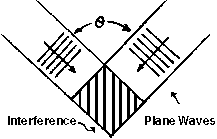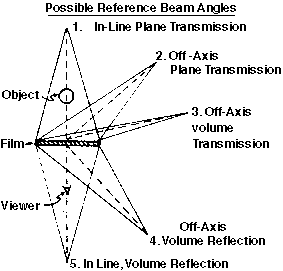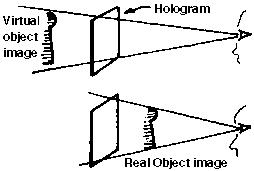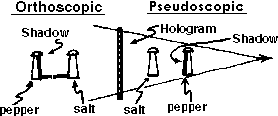There are numerous types of holograms. It is important to learn the basic differences between the various types and what terms are used in referring to them so that you will understand immediately what someone means if they say, for example, they have just made a reflection hologram or transmission hologram or in line hologram. Holograms can differ in the way in which they are produced and they can incorporate and store the information for playback. The latter difference is the simplest to explain so we'll begin with that.
Under normal conditions we will be using a silver halide type film so we will talk about that specific case. The holographic information is coded in the emulsion according to the localized microscopic differences in the absorption of light or by the amount of silver halide converted to silver atoms during exposure and development. This is referrred to as an absorption hologram. The absorption pattern on the film corresponds with the amount of light incident on the plate during exposure. If that same hologram is put through a bleaching process it will then be termed a phase hologram. Bleaching is discussed in detail in chapter 10. The absorption index by changing the different residues of silver to corresponding thickness of transparent substance. The hologram is then played back by the refraction of the reference beam dictated by changes of refraction in the emulsion. In a phase hologram the reference beam is phase modulated in order to reconstruct the wavefronts of the original objects. In absorption holograms the reference beam is diffracted by the small patterns of exposed emulsion in the form of silver residue.
Many holographers bleach all of their holograms because phase holograms absorb less valuable reconstructing laser light than the absorption type and thus create a brighter image. However, some holographers do not bleach regularly, especially if they have made a perfect exposure in their original hologram. This is due to the fact that there is a slight loss of resolution along with the gain in brightness. Also, a poor bleaching technique increases the amount of noise and can greatly reduce the resolution. The source of the controversy, if any, is merely personal taste.
It is important to remember that the term absorption or phase hologram has nothing to do with way the hologram was exposed but, in the case of silver halide emulsion, refers only to a bleaching process which follows exposure and development, (although you may alter your development process if you know in advance you are going to bleach).
The following different types of holograms have special terms because they are actually constructed using different beam arrangements.. Remeber all the different types I'm about to describe can ultimately be either absorption or phase type holograms.
The inherent difference between holograms has caused scientists and holographers to develop special terms or adjectives for them. In the construction stage the difference is usually nothing more than the beam and object beam, as they interfere on the film. This angle difference can produce very pronounced differences between holograms in the playback stage. For example, a plane transmission hologram has to be reconstructed with laser light or a specially filtered light which approaches coherency in order for the reconstructed image to be crisp. A white light reflection hologram can in comparison be viewed quite clearly with sunlight or under ordinary incandescent light sources.
Very simply, as the angle difference between reference and object beam increases, the tiny patterns in the emulsion exposed by the crest-crest interference of light waves are set up closer and closer together. We'll discuss later the resulting properties of the varying distances between fringes, or the dark exposed areas in the hologram emulsion, but first let's get some terms straight.

The first hologram ever made by Dennis Gabor, in 1947, was an in-line, plane, transmission type. Remember at this time the laser was still yet to be developed, so Gabor had to make due with the quasi-coherent light gained by squeezing light from a mercury vapor lamp through a pinhole and then color filtering it (he used the 0.546 micron mercury green line). In-line means that the reference beam and object beam are coming from the same direction or are the same beam. Gabor had to do this in order to mantain the little coherency he had gained. All in-line holograms are also single beam set-ups. The same beam acts both as reference and object beam. This was made possible by using a transparency as the object. The light which went through the transparency before reaching the plate was modulated by the transparency, the light which went through it and was not effected by the transparency was the reference beam. The diffracted light and reference light interfered on the emulsion of the hologram and thus fulfilled one basic requirement for the construction of a hologram. When the reference beam was later shown back through the hologram at the same angle relationship it had with the plate in the reconstruction stage an image appeared. A poor image due to the lack of coherent light, but worse still the reference beam shone directly into the viewers eye, thus greatly compromising the viewing of the reconstructed object. Although it was a poor image it was there in all its dimensionality. A new medium had been born, alas, a little prematurely and in 1948, was placed on the shelf until the advent of the laser.
Please note that through his experiments Gabor proved that an interference pattern carries all the information about the original object and that from the interference pattern one can reconstruct the object. For the discovery of these now well accepted concepts, Dennis Gabor received the 1971 Nobel Prize in Physics.
As I mentioned above in order to playback a hologram the reference beam must be shone back through the hologram at the same angle relationship as it had in construction. This is where the term transmission hologram arises. Transmission merely means that the reference beam must be transmitted through the hologram in order for the image to be reconstructed.
In 1962 Leith and Upatnieks at the University of Michigan removed Gabor's brain child from the shelf and gave holography its rebirth. Like Gabor they did their early experiments with a filtered mercury arc lamp. Leith and Upatnieks invented the off-axis reference beam with all its great advantages which they did not even appreciate at the time. After the developlment of the continuous wave gas laser in 1960 by Ali Javan et al. Leith and Upatnieks started using the laser and discovered the three dimensionality of the images. They performed these experiments as an adjunct to their work in side-looking microwave radar. They independently discovered off-axis holography only to find that Gabor had proposed holography 12-14 years earlier.
The term off-axis means that the reference beam and object beam are not coming from the same direction. Naturally in order to perform this feat we must have two different beams, thus the term twin beam. Because the laser gives a homogenous beam of coherent light we can extract a beam from the original beam as I mentioned earlier. This is done with the aid of a beam splitter, which could be nothing more than a piece of optical glass. A part of the original beam goes through the glass and a part is reflected at the same angle as its incident. This allows one to bring in the reference beam from an infinite number of angles in relation to the object directed beam, thus avoiding the inconvenience in play back of having to look directly in the reference beam as with the in-line, transmission hologram.
This is a good time to point out the differences between a plane hologram and a volume hologram. As the angle difference between the object beam (or the wavefronts bouncing off the object) and the reference beam changes, so does the spacing of the patterns in the emulsion. As long as the angle difference remains less than 90 degrees the hologram is called a plane hologram. Plane meaning that the holographic information is primarily contained in the two-dimensional plane of the emulsion. Although the emulsion does have a thickness, usually around seven microns or 7/millionths of a meter, the spacing between fringes is large enough, when the angle is under 90 degrees, for us to imagine that the depth of the emulsion isn't really being utilized in the recording of the hologram. At 90 degrees, which is really a convenient but arbitrary point, the angle is great enough and fringe spacing has become small enough for us to say that the recording process is taking place throughout the volume of thickness of the emulsion. A point to remember is that although there are different thicknesses of emulsion put on celluloid or glass plates seven microns is an average. One can use the same emulsion say seven microns thick, and make both plane and volume holograms depending on the angle difference between reference and object beam.
Thus if you imagine your film in a fixed plane and your object in a stationary position, as you rotate the incidence angle of the reference beam, you can determine whether you are making a plane or volume holograms. If your angle is under 90 degrees it's plane, from 90 degrees - 180 degrees it's volume. Naturally, past 180 degrees you merely begin coming back the other way, through the volume to the plane and when finally you reach 360 degrees you are back at the in-line, plane, transmission hologram and you can collect your $200.

A very important point for differentiation occurs as the reference beam swings around its arc of possible positions. In a plane transmission hologram the reference beam is hitting the film from the same side as the object beam. In a volume reflection hologram the reference beam has made an arc clear around so that it hits the film from the opposite side as the modulated object beam. When 180 degrees difference is reached you are the constructing an in-line, volume, reflection hologram.
A transmission type hologram means that the reference beam must be transmitted through the hologram, in order to decode the interference patterns and render the reconstructed image. The light which is used for playback must be coherent or semi-coherent or the image will not be sharp. If a non-coherent source, such as the light from a common, unfiltered slide projector is used, then the hologram will diffract all the different wavelengths. The interference pattern or grating etched in the emulsion is not particular as to which wavelengths it bends or focuses; therefore, you end up with an unclear overlapping spectrum of colors which somewhat resemble your object.
A hologram will playback just as well with laser light of a different color or wavelength than the light with which it was made. However, the object will appear to be of a different size and/or distance from the plate. For example, a hologram of an object made with neon or red light will playback that object smaller or seemingly further away if a blue color laser is used. This is because the grating will bend the blue or shorter light less severely than the red with which it was made and with which it is meant to be decoded.
Unlike a plane hologram, sometimes called a thin hologram, which requires a coherent or highly filtered playback source, a reflection, or thick, hologram can be viewed very satisfactorily in white light or light which contains many different wavelengths. The one requisite is that the light be from a point source and be a somewhat straight line, such as a slide projector light or penlight, or the sun on a clear day. The reflection hologram can do this because in a way it acts as its own filter.
In a reflection hologram the fringes are packed so closely together that they constitute layers throughout the thickness of the emulsion. The spacing between fringes remains constant. If "d" or the distance between fringe one and two is two microns for example, then the distance between the remaining layers of fringes will also be two microns. This distance is a function of the wavelength of light used in constructing the hologram and also the angle difference between reference and object beam. This layered affair allows the reflection hologram to absorb, or not reflect, any of the colors or wavelengths of light which are not the correct length. The wavelength which matches the fringe spacing will be reflected: the crests of the wavelengths which are too short or too long will eventually miss one of the planes and be absorbed into the darkness of the emulsion.
In a reflection type hologram the playback light or reconstruction beam comes from the same side of the hologram as the viewer. Some parts of the incident light are reflected, some are not, depending on the interference pattern. If the hologram was made correctly the result should be a visible three dimensional image. As I mentioned before in the transmission type the reconstruction beam must pass through the hologram and come towards the viewer from the opposite side of the hologram while in the reflection type the playback source comes from the same side of the hologram as the viewer.
Incidentally just as very few transmission holograms are made in-line or 0 degrees so are very few reflection holograms made inline or else you would have to hold your point light source in your teeth or perhaps invest in a miner's cap. Most reflection holograms are made at a less severe angle, perhaps 160 degrees, so that the light can come in at an angle without being blocked by the person who is trying to see the hologram.
The image produced by the hologram can either appear to be in front of the holographic plate or film, or behind the film. In the former case it is called a real image (projection) and the latter a virtual image. If you imagine your position as viewer to be constant then you can easily determine whether an image is real or vitual. If the image appears between you and the hologram it is a real image, if the hologram is between you and the apparent object then it is called a virtual image.

To view a virtual image you must look through the hologram to perceive the object floating in the space behind it. In order to see a real image you look at the hologram and see the object in free space in front of the hologram. It is a little more difficult to view a real image because you have to find the image or focus your eyes in front of the hologram and in this case the hologram is less capable to act as a guide for your eyes. You may move a screen or sheet of paper back and forth in front of the hologram in order to find where the object is focused and then, keeping your eye on that place in space, remove the sheet and look straight into the hologram.
The real image is very exciting but there are a number of drawbacks. The object holographed should be quite a bit samller than the size of the film you are using, if not, you will not be able to see the complete real image of the object all at once. It will necessitate craning your neck and stretching in all which ways to see parts of the whole object or objects. Also, unless you take special precautions in the construction of the hologram, the real image will be pseudoscopic. This means simply that everything that was closer to the film when the hologram was made will now be further away and vice versa. This includes both individual objects in a shot or the different planes of space of an individual object. The pseudoscopic image is made by reversing the direction of the reference beam, or by turning the completed hologram around until seeing the image in front of the plate.
For example, if in making your hologram you placed a salt shaker closer to the film than a pepper shaker (let's imagine the salt shaker is even casting a shadow from the object beam onto the pepper shaker), then in a pseudoscopic playback as a real image the pepper shaker will appear to be closer to you than the salt shaker which is no longer there.

Naturally, if you playback the virtual image of the same hologram the shakers would resume their original positions (in the latter sections we will discuss further the real image hologram, show possible ways of making holograms specifically for real image playback and also touch lightly on why there is a real image.)
In addition to the previously mentioned types of holograms commonly made today there is the multiplex hologram and the image hologram. These types of holograms are being used more commonly today.
Very simply the multiplex hologram is the holographic storage of photographic information. In the first stage a series of photographs or a certain amount of motion picture footage of the subject is exposed. The number of stills or frames taken depends on how much of an angle of view you want of the subject in your finished hologram. For example if you want a 360 degree view of the subject you might expose 3 frames per degree of movement around the subject (usually the camera remains stationary and subject rotates) this will result in the exposure of 1080 frames. When your film is developed you proceed to the holographic lab and (using a laser) make a series of "slit" holograms using each frame of film as a subject for each slit of holographic film. The slits are usually about one millimeter wide and are packed so closely that there is no "dead space" in between. Also the hologram is bleached so that the strips disappear. Usually a multiplex hologram yields horizontal not vertical parallax. This is because the camera usually moves around (or the subject moves around in front of the camera) and doesn't usually pass over the subject. Also, psychologically, horizontal parallax is much more desirable and the lack of horizontal parallax, to humans, is much more noticeable than the lack of vertical parallax. The multiplex hologram is usually, though not always, made on flexible film coated with the same holographic emulsion as the plates. The procedure can be totally mechanized so that a machine can expose a slit hologram per each frame af footage at a very rapid pace. The advantage of this type of hologram is that you can now have a hologram of almost anything you can capture on ordinary film without the need of the expensive, clumsy pulse ruby laser. The disadvantage is that it is not truly a hologram but photographic information holographically stored. It seems that it will have a very solid place in the growing field of display and advertising holography.
The image hologram which was mentioned earlier also has an advantage which will make it one of the types widely used in display holography. The image hologram can be played back with ordinary "white light" from an uncoated incandescent bulb. An image hologram can be either reflection type or trasmission type however, it is more impressive as a transmission type because unlike an ordinary transmission hologram the image transmission hologram can play back well with an unfiltered white light source. The image hologram can be formed by placing the correct lens between the subject or scene and the holographic film plane. The subject is thusly focused directly onto the film plane and a hologram is made of that focused image. This type of hologram is very pleasing because the object seems to come out at you like a real image but it is not pseudoscopic. The real advantage is that the image transmission hologram has much less color dispersion or spectral smear than an ordinary transmission hologram and when you playback with an ordinary uncoated light bulb there is a rainbow effect but the image remains very sharp. Another way to make an image hologram is by copying the focused real pseudoscopic image of an original or master hologram. The result is a second generation image transmission hologram whose virtual image is orthoscopic.
 On to the next chapter.
On to the next chapter.
 Holocom!
Holocom!